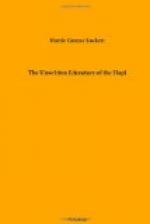[Footnote 21: Voth, H.R., Op. cit, p. 11.]
Thus we have at least three distinct points in this one myth that account for three definite things we find the Hopi doing today: (1) Note that it was “our old men” who got from the gods the magic seed of the tall cane which brought relief to the people. To this day it is the old men who are looked up to and depended upon to direct the people in all important matters. “It was always that way.” (2) While the magic song lasted the people came through the sipapu, but when the song ended no more could come through, and there was weeping and wailing. Singing is today the absolutely indispensable element in all magic rites. There may be variation in the details of some performances, but “unless you have the right song, it won’t work.” The Hopi solemnly affirm they have preserved their original emergence song, and you hear it today on the first morning of the Wu-wu-che-ma. (3) The sipapu seen today in the floor of the kiva or ceremonial chamber symbolizes the passage from which all mankind emerged from the underworld, so all the Hopi agree.
The belief of the present-day Hopi that the dead return through the sipapu to the underworld is based firmly upon an extension of this myth, as told to Voth,[22] for it furnishes a clear account of how the Hopi first became aware of this immortality.
[Footnote 22: Voth, H.R., Op. cit, p. 11.]
It seems that soon after they emerged from the underworld the son of their chief died, and the distressed father, believing that an evil one had come out of the sipapu with them and caused this death, tossed up a ball of meal and declared that the unlucky person upon whose head it descended should be thus discovered to be the guilty party and thrown back down into the underworld. The person thus discovered begged the father not to do this but to take a look down through the sipapu into the old realm and see there his son, quite alive and well. This he did, and so it was.
Do the Hopi believe this now? Yes, so they tell you. And Mr. Emery Koptu, sculptor, who lived among them only a few years ago and enjoyed a rare measure of their affection and good will, recently told the writer of a case in point:
On July 4, 1928, occurred the death of Supela, last of the Sun priests. Mr. Koptu, who had done some studies of this fine Hopi head, was in Supela’s home town, Walpi, at the time of the old priest’s passing.
The people were suffering from a prolonged drouth, and since old Supela was soon to go through the sipapu to the underworld, where live the spirits who control rain and germination, he promised that he would without delay explain the situation to the gods and intercede for his people and that they might expect results immediately after his arrival there. Since his life had been duly religious and acceptable to the gods, it was the belief of both Supela and his friends that he would make the journey in four days, which




